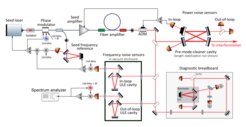A prototype laser for the Einstein Telescope
AEI researchers develop prototype of a pre-stabilized laser system at 1550 nm wavelength for third-generation gravitational-wave detectors
For future gravitational-wave detectors novel and highly stabilized laser systems operating at longer wavelengths are required. Building on their earlier characterisation of commercially available components, AEI researchers have developed such a stabilized laser system with with a wavelength of 1550 nm that can serve as a prototype system for third-generation detectors. The laser runs at 2 W and is simultaneously stabilized in laser power and frequency. Its control loop topology and performance are suitable for future detectors, such as the Einstein Telescope. It could also be extended to higher laser power of up to 100 W if required. The setup can be used for other optical precision experiments and the concepts can be transfered to 2 µm wavelength, which is considered as an alternative for third-generation detectors.
Paper abstract

Proposed future gravitational wave detectors place high demands on their pre-stabilized laser system. We present a prototype for such a pre-stabilized laser system at 1550 nm wavelength with frequency and power stabilizations optimized for the needs of gravitational wave detectors. A power stabilization with shot noise limited operation below a relative power noise of 1 × 10−8 Hz−1/2 between 100 Hz to 100 kHz and an active frequency stabilization with a unity-gain bandwidth above 2 MHz were operated simultaneously. Out-of-loop measurements are performed to characterize the achieved stability and to analyze sensor noise limits. We find that non-linear noise couplings at the spatial mode-filter cavity are of high relevance and lead to increased frequency stability requirements above 100 kHz. This pre-stabilized laser system can serve as the baseline for the Einstein Telescope gravitational wave detector and demonstrates stabilization concepts generally applicable to optical precision experiments.












